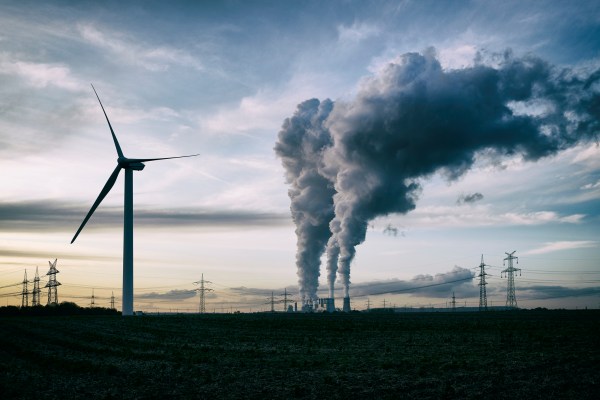Ten years after a cap-and-trade scheme championed in part by John Kerry was unceremoniously killed by one of his colleagues across the aisle, the former senator turned climate envoy is once again pitching the policy as a solution to climate change.
As an idea, cap and trade isn’t bad! It works by having governments cap pollution levels and allot limited permits to polluters so they figure out how best to clean things up. Oftentimes the answer is better technology. Other times the answer is to buy permits from other companies that have done a better job at cutting their emissions. Over time, the number of permits gets ratcheted down and pollution levels drop.
As a policy, cap and trade has been widely applied, in many cases successfully. The U.S. used one in the 1980s to successfully slash sulfur dioxide pollution that was causing acid rain and again in the 2000s to cut levels of nitrogen oxides. The EU is currently using one to trim its carbon emissions, and there are a few regional systems in North America.
Kerry’s new proposal, as reported by the Financial Times, hopes to use cap and trade to encourage investment in the power sectors of developing countries. It’s a policy that’s heading in the right direction, though with enough missing pieces to have me wondering whether it’ll turn out to be a bust or a diplomatic breakthrough, similar to the Paris Agreement. Here’s how it would work.
Governments, regional or national or both, would earn carbon credits by reducing emissions from their power sector. In many developing economies, those emissions spew largely from coal-fired power plants, which are cheap to build and run. The carbon credits would be granted by an unspecified accreditor, who would do the hard work of verifying whether the governments’ claims live up to reality.
Governments could then sell those credits to companies that either don’t want to cut their emissions (oil and gas) or are having a hard time doing so profitably (steel, cement). In theory, the proceeds from the credit sales would help ease the energy transition for developing countries.
There aren’t a lot more details than that, and when it comes to carbon markets, details kind of matter.
For one, there’s the question of how to get the whole thing rolling, a chicken/egg problem. Nobody likes coal power because it’s somehow better than any other kind of power; they like it because it doesn’t cost a lot of money. In Kerry’s scheme, credits are issued when a country cuts emissions. Without credits to sell, where will it get the money to fund the initial emissions cuts? Presumably, if the market is up and functioning correctly, you could use future credits to secure debt, but there are some big “ifs” involved in that approach.
One such “if”: What if renewables drop in price so quickly that coal plants get scrapped anyway because wind and solar are cheaper to build than coal is to operate? That would be a good problem to have, actually.
OK, so here’s a more realistic “if”: What if the price to cut carbon is less than expected? Does that stifle innovations that would otherwise facilitate deeper cuts? The EU experienced that phenomenon, where initial cuts were cheaper than predicted, and the bloc had to rejigger its carbon market as a result. It’s not a huge problem, but it does illustrate why details matter.
Another “if”: What if the market moves too slowly? Some countries are still building coal plants! In 2022! They probably have an expectation that those power plants will still be running in 20 or 30 years. What would it take to get them to shut them down? Quite a lot of money, I’d think, which might drive the price of carbon credits too high, discouraging companies from participating in the market and bringing the whole thing to a grinding halt.
One more “if’: What if the countries that dominate coal use don’t want to play along? Six countries — China, India, Vietnam, Indonesia, Turkey and Bangladesh — operate 82% of the world’s coal-fired power plants, according to the United Nations Framework Convention on Climate Change. What if they like using coal because it offers strategic advantages? China, for example, is really good at building coal plants, and it’s been using that expertise to build power plants in other countries, helping them electrify. It also buys a ton of coal from places like Australia, helping prop up large parts of the Aussie economy. There are geopolitical considerations that could keep countries from joining.
Which leads to the final potential problem — participation would be voluntary. Under the proposal Kerry is floating, countries would be under no obligation to join. If no one has to join, why would anyone join? Another chicken-and-egg problem. Developing countries, which don’t have the benefit of enormous treasuries like the U.S. or EU countries, may not be willing to take the gamble if they don’t think others will join them.
But the voluntary nature might also be the thing that gets it off the ground. For decades, international progress on climate change stalled as countries (mainly the U.S., but also Russia and a few others) balked at signing binding treaties. The Paris Agreement was the breakthrough that arguably unleashed the wave of progress we’ve seen over the last few years, and that was basically a series of promises. It didn’t really have any teeth.
What it did seem to do was create a spirit of cooperation. Countries stopped pointing so many fingers. Are we on track to achieving the Paris Agreement’s goal of limiting warming to 1.5 degrees Celsius? No, definitely not. But are we at least heading in the right direction? Yes.
Kerry seems to have learned a lesson or two over the years, and his new cap-and-trade scheme may succeed because what have traditionally been seen as flaws might instead give it the flexibility it needs to work.
